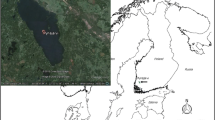Abstract
A change for the worse in water quality in Lake Biwa has led to musty odor of tap water, freshwater red tide and other water blooms by sudden propagations of nuisance planktonic algae since 1970. Further, some endemic and commercially important species of fish and molluscs decreased drastically in the last 10–30 years. These events seemed to be closely related to drainage of many small lakes channeled to Lake Biwa as part of an agricultural policy after World War 11, and to senseless exploitation of the littoral zone in the 1970s and 1980s as a link in the Comprehensive Development Project of Lake Biwa. Simplification of its littoral zone has led to a deterioration in its ecosystem through physical destruction of spawning habitats and increase in eutrophication.
Similar content being viewed by others
References
Horie, S.: Introduction of Lake Biwa. In: Horie, S. (ed.), Lake Biwa, pp. 1–2. Dr. W. Junk Publishers, Dordrecht 1984.
Ichise, S.; Wakabayashi, T.; Yamanaka, S.; Sono, F.; Naito, M.; Kawabe, K.; Maehata, K.; Tanaka, K.: Nomura, K.: Abnormal growth of picoplankton occurred in Lake Biwa, 1989–1990. Rep. Shiga. Pref Inst. Pub. Hlth. and Environ. Sci. 26, 138–147 (1991).
Ishida, Y.: Growth process of Uroglena in lake water. In: Kadota, H. (ed.), The Freshwater Red Tide, pp. 184–204. Kouseisya Kouseikaku, Tokyo 1987.
Kinki Noseikyoku Shiga Tokei Joho Jimsho: Quick Report of Agriculture and Fisheries, pp. 1-4 (1951-1993) (In Japanese).
Kumagai, M; Fushimi, H.: Inflows due to snow melt. In: Okuda, S.; Imberger, J.; Kumagai, M. (ed.), Physical Processes in a Large Lake: Lake Biwa, Japan. Coastal and Estuarine Studies, 48, 129–139. American Geophysical Union, Washington, DC 1995.
Kurata, A.: Small lakes channeled to Lake Biwa — Ecological function. LBRI Bulletin 2, 46–54 (1983) (In Japanese).
Mori, S.: Molluscs in Lake Biwa. In: Horie, S. (ed.), Lake Biwa, pp. 331–337. Dr. W. Junk Publishers, Dordrecht 1984.
Nakanishi, M.: Human life and Lake Biwa. In: Takahashi, M.; Ishida, N. (ed.), For Persons to Study on Environment, pp. 74–84. Sekai shisosya, Kyoto 1993.
Shiga Prefecture: White Paper on the Environment, pp. 1–446. Shiga Prefecture, Japan 1992 (In Japanese).
Suzuki, N.: Drinkable Water and Unbelievable Story, pp. 1–281. Shimin-Bunkasha, Shiga 1988 (In Japanese).
Tezuka, Y.: Recent trend in the eutrophication of the north basin of Lake Biwa. Jpn. J. Limnol. 53, 139–144 (1992).
Tokui, T.; Kawanabe, H: Fishes in Lake Biwa. In: Horie, S. (ed.), Lake Biwa, pp. 339–360. Dr. W. Junk Publishers, Dordrecht 1984.
Author information
Authors and Affiliations
Rights and permissions
About this article
Cite this article
Nakanishi, M., Sekino, T. Recent drastic changes in Lake Biwa bio-communities, with special attention to exploitation of the littoral zone. GeoJournal 40, 63–67 (1996). https://doi.org/10.1007/BF00222532
Received:
Accepted:
Issue Date:
DOI: https://doi.org/10.1007/BF00222532




